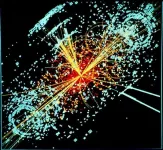(Press-News.org) Since astronomers captured the bright explosion of a star on February 24, 1987, researchers have been searching for the squashed stellar core that should have been left behind. A group of astronomers using data from NASA space missions and ground-based telescopes may have finally found it.
As the first supernova visible with the naked eye in about 400 years, Supernova 1987A (or SN 1987A for short) sparked great excitement among scientists and soon became one of the most studied objects in the sky. The supernova is located in the Large Magellanic Cloud, a small companion galaxy to our own Milky Way, only about 170,000 light-years from Earth.
While astronomers watched debris explode outward from the site of the detonation, they also looked for what should have remained of the star's core: a neutron star.
Data from NASA's Chandra X-ray Observatory and previously unpublished data from NASA's Nuclear Spectroscopic Telescope Array (NuSTAR), in combination with data from the ground-based Atacama Large Millimeter Array (ALMA) reported last year, now present an intriguing collection of evidence for the presence of the neutron star at the center of SN 1987A.
"For 34 years, astronomers have been sifting through the stellar debris of SN 1987A to find the neutron star we expect to be there," said the leader of the study, Emanuele Greco, of the University of Palermo in Italy. "There have been lots of hints that have turned out to be dead ends, but we think our latest results could be different."
When a star explodes, it collapses onto itself before the outer layers are blasted into space. The compression of the core turns it into an extraordinarily dense object, with the mass of the Sun squeezed into an object only about 10 miles across. These objects have been dubbed neutron stars, because they are made nearly exclusively of densely packed neutrons. They are laboratories of extreme physics that cannot be duplicated here on Earth.
Rapidly rotating and highly magnetized neutron stars,called pulsars, produce a lighthouse-like beam of radiation that astronomers detect as pulses when its rotation sweeps the beam across the sky. There is a subset of pulsars that produce winds from their surfaces - sometimes at nearly the speed of light - that create intricate structures of charged particles and magnetic fields known as "pulsar wind nebulae."
With Chandra and NuSTAR, the team found relatively low-energy X-rays from SN 1987A's debris crashing into surrounding material. The team also found evidence of high-energy particles using NuSTAR's ability to detect more energetic X-rays.
There are two likely explanations for this energetic X-ray emission: either a pulsar wind nebula, or particles being accelerated to high energies by the blast wave of the explosion. The latter effect doesn't require the presence of a pulsar and occurs over much larger distances from the center of the explosion.
On a couple of fronts, the latest X-ray study supports the case for the pulsar wind nebula -- meaning the neutron star must be there -- by arguing against the scenario of blast wave acceleration. First, the brightness of the higher energy X-rays remained about the same between 2012 and 2014, while the radio emission detected with the Australia Telescope Compact Array increased. This goes against expectations for the blast wave scenario. Next, authors estimate it would take almost 400 years to accelerate the electrons up to the highest energies seen in the NuSTAR data, which is over 10 times older than the age of the remnant.
"Astronomers have wondered if not enough time has passed for a pulsar to form, or even if SN 1987A created a black hole," said co-author Marco Miceli, also from the University of Palermo. "This has been an ongoing mystery for a few decades and we are very excited to bring new information to the table with this result."
The Chandra and NuSTAR data also support a 2020 result from ALMA that provided possible evidence for the structure of a pulsar wind nebula in the millimeter wavelength band. While this "blob" has other potential explanations, its identification as a pulsar wind nebula could be substantiated with the new X-ray data. This is more evidence supporting the idea that there is a neutron star left behind.
If this is indeed a pulsar at the center of SN 1987A, it would be the youngest one ever found.
"Being able to watch a pulsar essentially since its birth would be unprecedented," said co-author Salvatore Orlando of the Palermo Astronomical Observatory, a National Institute for Astrophysics (INAF) research facility in Italy. "It might be a once-in-a-lifetime opportunity to study the development of a baby pulsar."
The center of SN 1987A is surrounded by gas and dust. The authors used state-of-the-art simulations to understand how this material would absorb X-rays at different energies, enabling more accurate interpretation of the X-ray spectrum, that is, the amount of X-rays at different energies. This enables them to estimate what the spectrum of the central regions of SN 1987A is without the obscuring material.
As is often the case, more data are needed to strengthen the case for the pulsar wind nebula. An increase in radio waves accompanied by an increase in relatively high-energy X-rays in future observations would argue against this idea. On the other hand, if astronomers observe a decrease in the high-energy X-rays, then the presence of a pulsar wind nebula will be corroborated.
The stellar debris surrounding the pulsar plays an important role by heavily absorbing its lower energy X-ray emission, making it undetectable at the present time. The model predicts that this material will disperse over the next few years, which will reduce its absorbing power. Thus, the pulsar emission is expected to emerge in about 10 years, revealing the existence of the neutron star.
INFORMATION:
A paper describing these results was accepted into publication and is being published this week in The Astrophysical Journal and a preprint is available online. The other authors of the paper are Barbara Olmi and Fabrizio Bocchino, also from INAF-Palermo; Shigehiro Nagataki and Masaomi Ono from the Astrophysical Big Bang Laboratory, RIKEN in Japan; Akira Dohi from Kyushu University in Japan, and Giovanni Peres from the University of Palermo.
NASA's Marshall Space Flight Center manages the Chandra program. The Smithsonian Astrophysical Observatory's Chandra X-ray Center controls science from Cambridge Massachusetts and flight operations from Burlington, Massachusetts.
NuSTAR is a Small Explorer mission led by Caltech and managed by NASA's Jet Propulsion Laboratory for the agency's Science Mission Directorate in Washington. NuSTAR was developed in partnership with the Danish Technical University and the Italian Space Agency (ASI). The spacecraft was built by Orbital Sciences Corporation in Dulles, Virginia (now part of Northrop Grumman). NuSTAR's mission operations center is at UC Berkeley, and the official data archive is at NASA's High Energy Astrophysics Science Archive Research Center. ASI provides the mission's ground station and a mirror archive. JPL is a division of Caltech.
Unlike the Higgs boson, discovered at CERN's Large Hadron Collider in 2012 after a 40-year quest, the new particle proposed by these researchers is so heavy that it could not be produced directly even in this collider
The University of Granada is among the participants in this major scientific advancement in Theoretical Physics, which could help unravel the mysteries of dark matter
Scientists from the University of Granada (UGR) and the Johannes Gutenberg University Mainz (Germany) have recently published a study in which they endeavour to extend the Standard Model of particle physics (the equivalent of 'the periodic table' for particle physics) and answer some of the questions that this model is unable to answer. Such puzzles include: What ...
This study, published recently in the international journal Insects, was conducted by researchers from the University of Granada, the Doñana Biological Station, and the Biomedical Research Networking Centre for Epidemiology and Public Health (CIBERESP)
Researchers from the University of Granada (UGR), the Doñana Biological Station (EBD-CSIC), and the Biomedical Research Networking Centre for Epidemiology and Public Health (CIBERESP) have carried out the most comprehensive study to date of the eating patterns of the tiger mosquito (Aedes albopictus) and other invasive species of the same genus in Europe. The results of the study were recently published in the international journal Insects.
This research, which reviews ...
With a survival rate of only five years, the most common and aggressive form of primary brain tumor, glioblastoma multiforme, is notoriously hard to treat using current regimens that rely on surgery, radiation, chemotherapy and their combinations.
"Two of the major challenges in the treatment of gliomas include poor transport of chemotherapeutics across the blood brain barrier and undesired side effects of these therapeutics on healthy tissues," said Sheereen Majd, assistant professor of biomedical engineering at the University of Houston. "To get enough medicine across the blood brain barrier, a high dosage ...
Insomnia -- trouble falling asleep, staying asleep or waking up too early -- is a common condition in older adults. Sleeplessness can be exacerbated by osteoarthritis, the most common form of arthritis causing joint pain. While there are effective therapies for treating insomnia in older adults, many people cannot get the treatment they need because they live in areas with limited access to health care, either in person or over the internet.
With telephones nearly universal among the elderly, however, researchers at the University of Washington and Kaiser Permanente Washington Health Research Institute sought to determine if therapy using only a phone connection ...
CORVALLIS, Ore. - Flavor differences in whiskey can be discerned based solely on the environment in which the barley used to make the whiskey is grown, a new study co-authored by an Oregon State University researcher found.
This is first scientific study that found the environmental conditions, or terroir, of where the barley is grown impacts the flavor of whiskey, said Dustin Herb, an author of the study and a courtesy faculty member in the Department of Crop and Soil Science at Oregon State University.
"Terroir is increasingly being used to differentiate and market agricultural products, most commonly wine, as consumers grow more interested in the origins of their food," Herb said. "Understanding terroir ...
Slight differences in clinical features can help physicians distinguish between two rare but similar forms of autoimmune brain inflammation in children, a new study by UT Southwestern scientists suggests. The findings, published online in Pediatric Neurology, could provide patients and their families with a better prognosis and the potential to target treatments specific to each condition in the future.
About half of all cases of encephalitis - a rare type of brain inflammation that affects about 1 of every 200,000 people in the U.S. each year - can be traced to an infection. For a portion of other cases in which the cause isn't initially clear, researchers have discovered a link with the patients' ...
LEXINGTON, Ky. (Feb. 19, 2021) - After conducting a study to assess the need for cancer education materials in Appalachian Kentucky, members of the University of Kentucky Markey Cancer Center's Appalachian Career Training in Oncology (ACTION) program worked with faculty from the UK College of Education to create a three-part cancer education curriculum for middle and high school teachers in the region.
Kentucky is home to the highest rates of cancer incidence and mortality in the country, and that problem is further concentrated in the Appalachian region of the state. Funded by a grant from the National Cancer Institute, ACTION is a two-year program designed to prepare undergraduate and high school students for cancer-focused careers and is open to students who hail ...
WEST LAFAYETTE, Ind. -- Autonomous underwater vehicles have become versatile tools for exploring the seas. But they can be disruptive to the environment or have trouble traveling through confined spaces.
Purdue University researchers are studying an alternative: highly maneuverable, low-cost underwater gliders that operate silently. Components and sensors of the glider also can be easily swapped out or added according to a wide range of mission specifications.
"Our goal is persistent operation of mobile robots in challenging environments," said Nina Mahmoudian, associate professor of mechanical engineering. "Most underwater robots ...
BOSTON -- Numerous psychiatric studies have documented increased rates of depression and anxiety among those forced to relocate, with sudden moves often affecting individuals' social support and sense of identity and control. As the COVID-19 pandemic spread through the U.S. in March of 2020, universities evacuated students from their campuses, and thousands quickly relocated. Few studies have examined the mental health impact of the sudden disruption. In a new study of 791 undergraduate and graduate students, surveyed between April 9 and August 4, 2020, researchers from Brigham and Women's Hospital, Boston University's School of Social Work, and McLean Hospital revealed that students forced to relocate during the spring were more likely to report COVID-19-related ...
A study of adults in the United States finds that - broadly speaking - the older you are, the more concerned you are about COVID-19, and the more steps you take to reduce your risk from COVID-19. The study suggests that the biggest boost in risk reduction would stem from communication efforts aimed at raising awareness of COVID-19 risks among U.S. adults under the age of 40.
"Our study reinforces the idea that different generations perceive the risks associated with COVID-19 very differently," says Yang Cheng, corresponding author of the study and an assistant professor of communication at North Carolina State University. "It also highlights the need to do more to communicate the need for preventive measures ...




